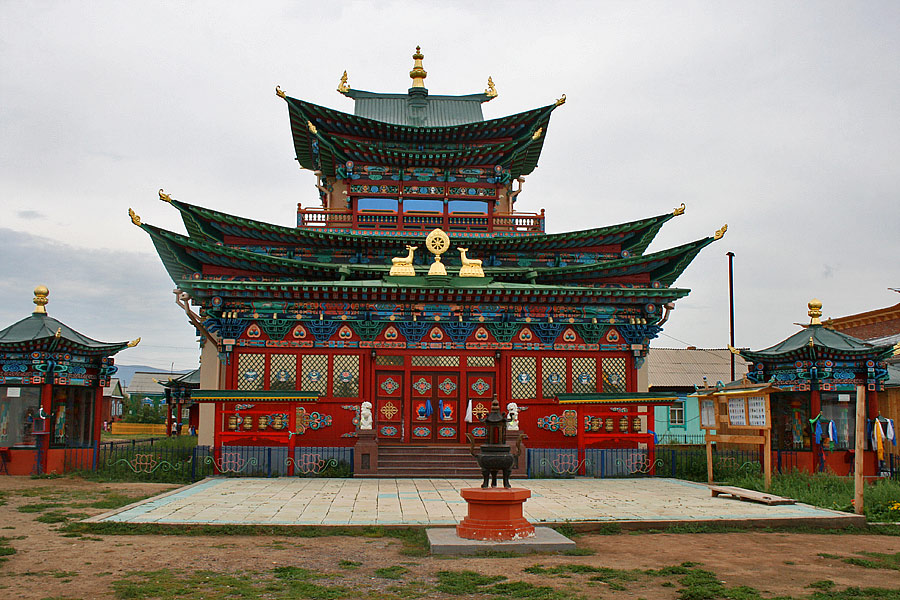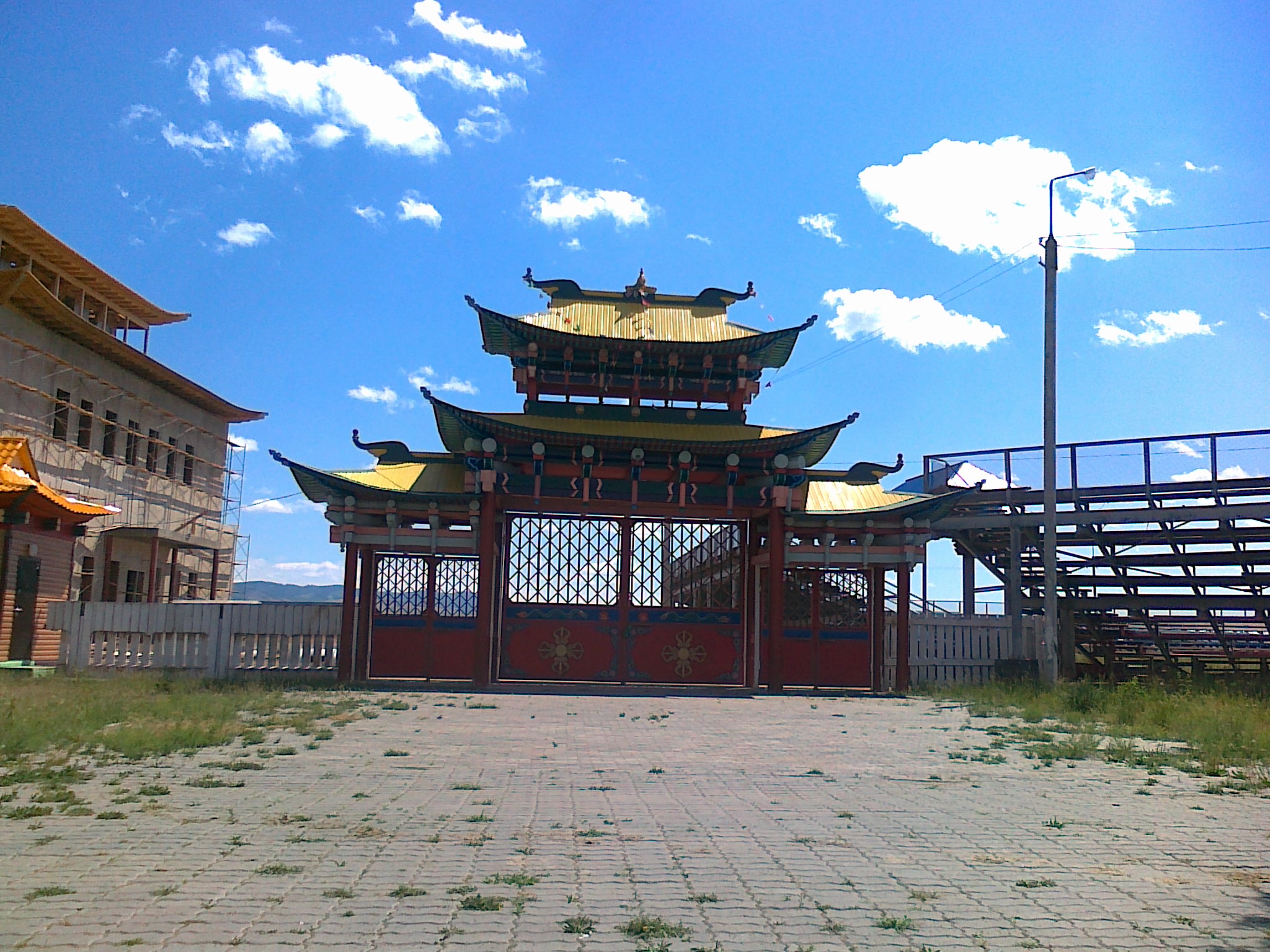Ivolginsky Datsan on:
[Wikipedia]
[Google]
[Amazon]



 Ivolginsky
Ivolginsky
Photograph of Ivolginsk Buddhist Datsan, Main Temple, Interior, Ivolga, Russia
*
Site of the Buruatian Ministry of Culture
*
*
Hambo Lama Itigelov
*
Hambo Lama Itigelov at the Buddhist Channel
* {{in lang, ru}
Official home page of the Ivolginsky datsan
Buddhism in Buryatia Buddhism in the Soviet Union Buildings and structures built in the Soviet Union Buddhist monasteries in Russia Gelug monasteries Buildings and structures in Buryatia Religious organizations established in 1945 Tourist attractions in Buryatia Buddhist temples in Russia 20th-century Buddhist temples Cultural heritage monuments in Buryatia Objects of cultural heritage of Russia of regional significance



 Ivolginsky
Ivolginsky datsan
Datsan ( mn, Дацан, russian: Дацан) is the term used for Buddhist university monasteries in the Tibetan tradition of Gelukpa located throughout Mongolia, Tibet and Siberia. As a rule, in a datsan there are two departments—philosophic ...
(russian: Иволгинский Дацан) is the Center of the Buddhist Traditional Sangha
Sangha is a Sanskrit word used in many Indian languages, including Pali meaning "association", "assembly", "company" or "community"; Sangha is often used as a surname across these languages. It was historically used in a political context t ...
of Russia, Buddhist Temple located in Buryatia, Russia
Russia (, , ), or the Russian Federation, is a transcontinental country spanning Eastern Europe and Northern Asia. It is the largest country in the world, with its internationally recognised territory covering , and encompassing one-eigh ...
, 23 km from Ulan Ude
Ulan-Ude (; bua, Улаан-Үдэ, , ; russian: Улан-Удэ, p=ʊˈlan ʊˈdɛ; mn, Улаан-Үд, , ) is the capital city of the Republic of Buryatia, Russia, located about southeast of Lake Baikal on the Uda River at its confluence wit ...
, near Verkhnyaya Ivolga village.
History
The datsan was opened in 1945 as the only Buddhist spiritual centre of theUSSR
The Soviet Union,. officially the Union of Soviet Socialist Republics. (USSR),. was a transcontinental country that spanned much of Eurasia from 1922 to 1991. A flagship communist state, it was nominally a federal union of fifteen nation ...
. In the course of time the little "Khambin's sume" changed into the Monastic centre with a residence of Pandido Khambo lama, the leader of all Russian Lama
Lama (; "chief") is a title for a teacher of the Dharma in Tibetan Buddhism. The name is similar to the Sanskrit term ''guru'', meaning "heavy one", endowed with qualities the student will eventually embody. The Tibetan word "lama" means "hig ...
s.
It was the residence of the Central Spiritual Board of Buddhists of the USSR and later of the Buddhist
Buddhism ( , ), also known as Buddha Dharma and Dharmavinaya (), is an Indian religion or philosophical tradition based on teachings attributed to the Buddha. It originated in northern India as a -movement in the 5th century BCE, and ...
Traditional Sangha
Sangha is a Sanskrit word used in many Indian languages, including Pali meaning "association", "assembly", "company" or "community"; Sangha is often used as a surname across these languages. It was historically used in a political context t ...
of Russia
Russia (, , ), or the Russian Federation, is a transcontinental country spanning Eastern Europe and Northern Asia. It is the largest country in the world, with its internationally recognised territory covering , and encompassing one-eigh ...
, as well as that of Pandido Khambo lama, the head of the Russian Buddhists. The spiritual activity of the datsan is manifested in temple rites, medical practice, and a traditional system of Buddhist education. The Buddhist university «Dashi Choinkhorling» was opened in 1991 attached to the datsan.
Treasures of culture
Although built in the late 1940s with light-colored brick, theUnique samples of old Buryat art, asain Ain (, ; frp, En) is a department in the Auvergne-Rhône-Alpes region in Eastern France. Named after the Ain river, it is bordered by the Saône and Rhône rivers. Ain is located on the country's eastern edge, on the Swiss border, where ...temple displays traditional proportions and ornamentation. The first level is devoted to study and prayer. The second level preserves sacred texts. The third level, the gonkan, serves as an inner sanctum devoted to the guardian deities. The gonkan is surrounded by an open gallery to allow ceremonial processions around the sacred space.
thangka
A ''thangka'', variously spelled as ''thangka'', ''tangka'', ''thanka'', or ''tanka'' (; Tibetan: ཐང་ཀ་; Nepal Bhasa: पौभा), is a Tibetan Buddhist painting on cotton, silk appliqué, usually depicting a Buddhist deity, scen ...
s, sculpture
Sculpture is the branch of the visual arts that operates in three dimensions. Sculpture is the three-dimensional art work which is physically presented in the dimensions of height, width and depth. It is one of the plastic arts. Durable sc ...
s, ritual objects are gathered and preserved at the Ivolginsky datsan. Among the monastery's treasures there is a collection of old Buddhist manuscripts written in Tibetan language Tibetan language may refer to:
* Classical Tibetan, the classical language used also as a contemporary written standard
* Lhasa Tibetan, the most widely used spoken dialect
* Any of the other Tibetic languages
See also
*Old Tibetan, the language ...
on natural silk, and a greenhouse with a sacred Bodhi tree.
As a cultural and religious monument, the Datsan is protected by the State. The Datsan Centre consists of such temples as Sockshin-dugan, Maidrin-sume, Devazhin and Sakhiusan-sume. There are also a library, a hotel, the Choyra (Faculty of Philosophy), Dashi Choinhorlin (building of the Buddhist University), Museum of Buryat Art, suburgans (stupas
A stupa ( sa, स्तूप, lit=heap, ) is a mound-like or hemispherical structure containing relics (such as '' śarīra'' – typically the remains of Buddhist monks or nuns) that is used as a place of meditation.
In Buddhism, circumamb ...
), some infrastructure buildings and lamas' houses.
Within the Datsan complex is the Korean style wooden Etigel Khambin temple which honors the 12th Khambo Lama whose body was recently exhumed.
Itigelov
In 1927, the 12th Pandito Hambo Lama of the Ivolginsky Datsan,Dashi-Dorzho Itigelov
Dashi-Dorzho Itigilov (russian: Даши-Доржо Итигэлов; bua, Этигэлэй Дашадоржо, ''Etigelei Dashadorjo''; 1852–1927) was a Buryat Buddhist lama of the Tibetan Buddhist tradition.
Born in the countryside of Bury ...
, told his students and fellow monks to bury his body after his death and to check on it again in 30 years. According to the story, Itigelov then sat in the lotus position, began chanting the prayer of death, and died, mid-meditation. The monks followed Itigilov's directions, and when they exhumed his body 30 years later, as the story goes, they were amazed to find none of the usual signs of decay and decomposition. Fearful of the Soviet response to the "religious miracle", the monks reburied Itigilov's body in an unmarked grave; packing the wooden coffin with salt.
Itigelov's story was not forgotten; a young lama named Bimba Dorzhiyez turned to a bhuddist whose father-in-law had witnessed the original exhumation. On September 11, 2002, the body was again exhumed, a process witnessed by twelve people, including two forensic scientists and a photographer. The official statement was issued about the body – very well preserved, without major signs of decay, whole muscles and inner tissue, soft joints and skin.
See also
*Buddhist monasteries in Russia
Buddhism ( , ), also known as Buddha Dharma and Dharmavinaya (), is an Indian religion or philosophical tradition based on teachings attributed to the Buddha. It originated in northern India as a -movement in the 5th century BCE, and grad ...
*Buddhism in the Russian Federation
Historically, Buddhism was incorporated into Siberia in the early 17th century. Buddhism is considered to be one of Russia's traditional religions and is legally a part of Russian historical heritage. Besides the historical monastic traditions ...
References
External links
Photograph of Ivolginsk Buddhist Datsan, Main Temple, Interior, Ivolga, Russia
*
Site of the Buruatian Ministry of Culture
*
*
Hambo Lama Itigelov
*
Hambo Lama Itigelov at the Buddhist Channel
* {{in lang, ru}
Official home page of the Ivolginsky datsan
Buddhism in Buryatia Buddhism in the Soviet Union Buildings and structures built in the Soviet Union Buddhist monasteries in Russia Gelug monasteries Buildings and structures in Buryatia Religious organizations established in 1945 Tourist attractions in Buryatia Buddhist temples in Russia 20th-century Buddhist temples Cultural heritage monuments in Buryatia Objects of cultural heritage of Russia of regional significance